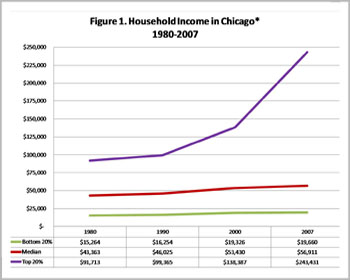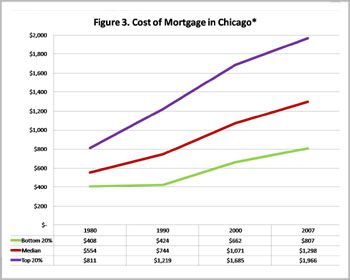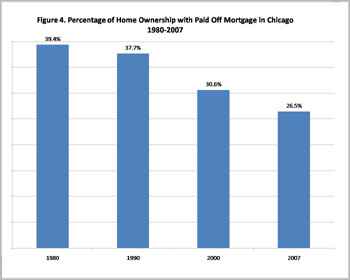By Kiljoong Kim
A century ago, Daniel Burnham’s plan to develop and redevelop Chicago after the Great Fire, commonly known as the Plan of Chicago of 1909, was launched with many great ambitions. And it’s been celebrated and studied as a classic model for urban design and development ever since. The Plan created a boulevard system, a lakefront largely accessible to the public, and many other amenities that we enjoy today. What is not well-known is that upon implementation, the rising cost of housing displaced many working class residents near downtown. Those residents were largely first-generation Czechs, East European Jews, Italians and Poles, as well as blacks from the South seeking factory jobs in the new industrial age.
Nearly a hundred years later, under the names of urban renewal, revitalization, gentrification, and globalization, the rising cost of housing begins to displace yet another set of working-class immigrants and racial minorities – primarily Mexicans and African Americans – out of several neighborhoods throughout the city. Such displacement is nearly complete in Lincoln Park, Bucktown, Wicker Park and the South Loop, and the progress is ongoing in Rogers Park, Uptown, Albany Park, Pilsen, Bronzeville and Kenwood/Oakland.
This brings up an interesting question of who gets to live in Chicago.
Given the degree of income inequality in the country, it is not surprising that household income for the top 10% of Chicago households is becoming more distant from the incomes of everybody else. What is surprising, however, is how the poor manage to keep themselves in the city despite of such disparity.
The increase in inequality largely comes from the gains of the wealthy, not from the loss of the poor. In 1980, the bottom 10% of households in Chicago earned less than $15,200 in 2007 dollars, while the top 10% households earned at least six times that in Chicago (Figure 1). By 2007, the bottom 10% experienced a slight increase in earnings to just under $19,660, while the top 10% earned more than $190,000 per year, or more than 12 times that of the bottom 10%.
 *Adjusted to 2007 dollars. Source: Minnesota Population Center
*Adjusted to 2007 dollars. Source: Minnesota Population Center
At the same time, the bottom 10% of renters experienced similar proportions of increase in their cost of housing as the top 10% of renters (Figure 2). The story was similar for those who own (Figure 3). This means that many poor residents are spending more money for their housing in Chicago without seeing their income rise proportionately.
 *Adjusted to 2007 dollars. Source: Minnesota Population Center
*Adjusted to 2007 dollars. Source: Minnesota Population Center
 *Adjusted to 2007 dollars. Source: Minnesota Population Center
*Adjusted to 2007 dollars. Source: Minnesota Population Center
One can easily envision various ways in which poor residents are contained and maintained. Once the city defined desirable areas for middle- and upper middle-class people and businesses, the city also began to carve out areas for the poor.
The inverse “L” shape of residential concentration along the West and South Sides of the city occupied mostly by poor African Americans has retained its shape since St. Clair Drake and Horace Roscoe Cayton mapped the area for their book Black Metropolis: A Study of Negro Life in a Northern City in 1945.
Sociologist Douglass Massey once pointed out that disparities encourage separation. In many ways, this increasing income and housing inequality explains why Chicago remains severely segregated. We come to believe that it is natural to live away from the poor, particularly poor blacks.
* * *
If the story of the poor is about stagnation, the story of the wealthy for the past few decades is about ambiguity. Perhaps the most interesting element about their wealth is that, despite soaring household income for the top 10% and steady increase for those in the middle, the percentage of those who own their homes outright without mortgages dramatically decreased in the city: What used to be nearly two out of five homes in 1980 became slightly over one out four by 2007 (Figure 4).
 *Adjusted to 2007 dollars. Source: Minnesota Population Center
*Adjusted to 2007 dollars. Source: Minnesota Population Center
Overall, this means Chicago residents spend more money on their housing than in the past, but such effort has not translated to a higher rate of financial worth through homeownership. All signs indicate that the increasing number of homes and properties in Chicago were owned by banks instead of individuals.
The decline in outright homeownership and subsequent increase in mortgages may explain the astounding number of foreclosures upon the housing market crash. But considering that all these trends started prior to the crash, it could also be about the transient nature of becoming a global city where people no longer live in one place, let alone one city, for long enough to pay off a house.
Given the recognition and the credit given to the Burnham Plan for all that is right about Chicago, it is not surprising that those displaced were simply labeled as the price to pay for the good of the masses. History rarely remembers the poor that are pushed around because they rarely receive opportunities to write their stories. But if the poor do not have a voice, then the current trend could mean that the history of Chicago becomes the story of increasingly fewer people.
–
Kiljoong Kim is a research consultant and doctoral student in sociology at the University of Illinois at Chicago. He welcomes your comments. Read more in the the Who We Are archives.
Posted on September 7, 2009


